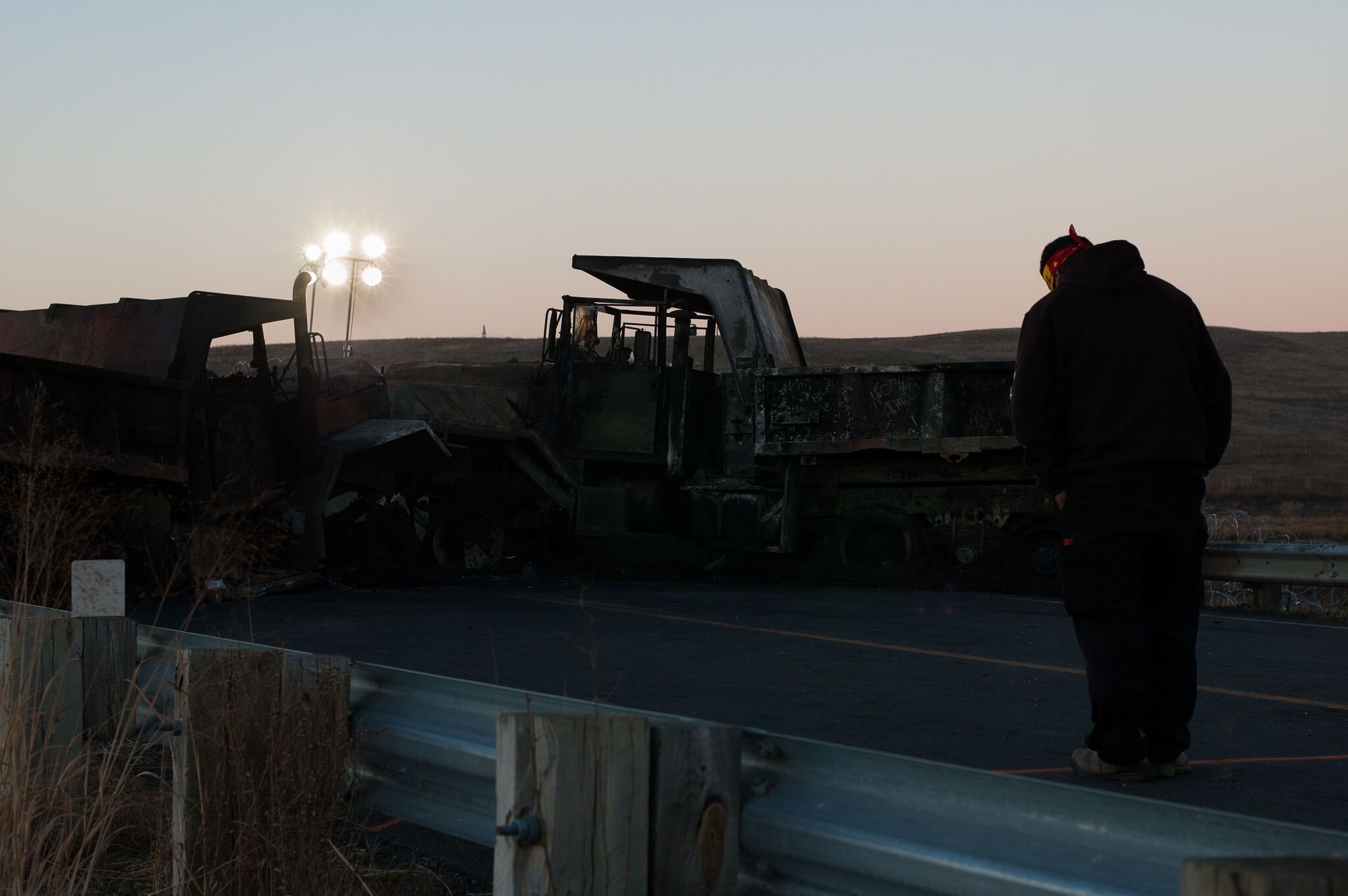
by Deep Green Resistance News Service | Jul 20, 2018 | Colonialism & Conquest
Featured image: Dakota Access Pipeline Resistance Camp, October 12, 2016. Photo: Irina Groushevaia/flickr.
by Rebecca Pilar Buckwalter Poza / Intercontinental Cry
Standing Rock protesters faced below-freezing conditions, water cannons, sponge rounds, bean bag rounds, stinger rounds, teargas grenades, pepper spray, Mace, Tasers, and even a sound weapon. Officers carried weapons openly and threatened protesters constantly, by many accounts. Hundreds of protesters were injured, and more than two dozen were hospitalized.
As of November 2016, 76 local, county, and state agencies had deployed officers to Standing Rock. Between August 2016 and February 2017, authorities made 761 arrests. One protester was arrested and slammed to the ground during a prayer ceremony; another described being put in “actual dog kennels” with “photos of the types of dogs on the walls and piss stains on the floor” in lieu of jail. She wasn’t told she was under arrest; she wasn’t read her rights. Once detained, protesters were strip searched and denied medical care. Belongings and money were confiscated, the latter never returned.
Law enforcement officers razed the camp in February 2017. The protest may have ended, but aggression against protesters did not. Law enforcement and prosecutors’ efforts to charge protesters with as serious a crime as possible have become battles to convict them and obtain the maximum sentence possible.
During a Oct. 27, 2016, roadblock protest of the Dakota Access Pipeline at Standing Rock, several fires were set. By whom, no one knew. Prosecutors charged Little Feather of the Chumash Nation, also known as Michael Giron, and Rattler of the Oglala Lakota, Michael Markus, with “use of fire to commit a felony” as well as civil disorder, anyway. The charging documents cite knowledge of “several fires … set by unidentified protesters.”
Police tactics on Oct. 27, by the way, included the use of pepper spray and armored vehicles. Law enforcement and prosecutors only became more aggressive after President Trump assumed office, at his direction.
Both Little Feather and Rattler opted to plead guilty, not because there was adequate evidence against them but because the mandatory minimum sentence would be 10 years if they were convicted at trial. That was a risk not worth taking: The Guardian has reported that surveys found 84 to 94 percent of the jury pool has prejudged Standing Rock protesters. Little Feather was sentenced to three years in prison. Rattler is expected to receive the same or a similar sentence.
A third protester, Red Fawn Fallis, pleaded guilty to charges of civil disorder and illegal possession of a firearm by a convicted felon. She was accused of firing a gun during the protest, though she said she doesn’t remember doing so. The gun in question was owned by an informant who allegedly seduced Fallis. Despite these obvious flaws, she and her attorneys opted not to risk trial, citing both anti-protester sentiment and lacking disclosure by the prosecution. She received a 57-month sentence.
The ongoing experiences of Standing Rock protesters are all the more horrifying in contrast with the recent pardon of Dwight and Steven Hammond. Trump pardoned the pair, who’ve long “clashed” with the federal government, at the behest of a “tycoon” friend of Vice President Mike Pence. Both had been convicted of setting fires on federal land for a 2001 fire, while only Steven was convicted of a 2006 fire. When the mandatory minimum sentence for the pair—who originally benefited from pro-rancher bias—was imposed on appeal, it sparked an armed standoff led by another famous family of anti-government extremists, the Bundys.
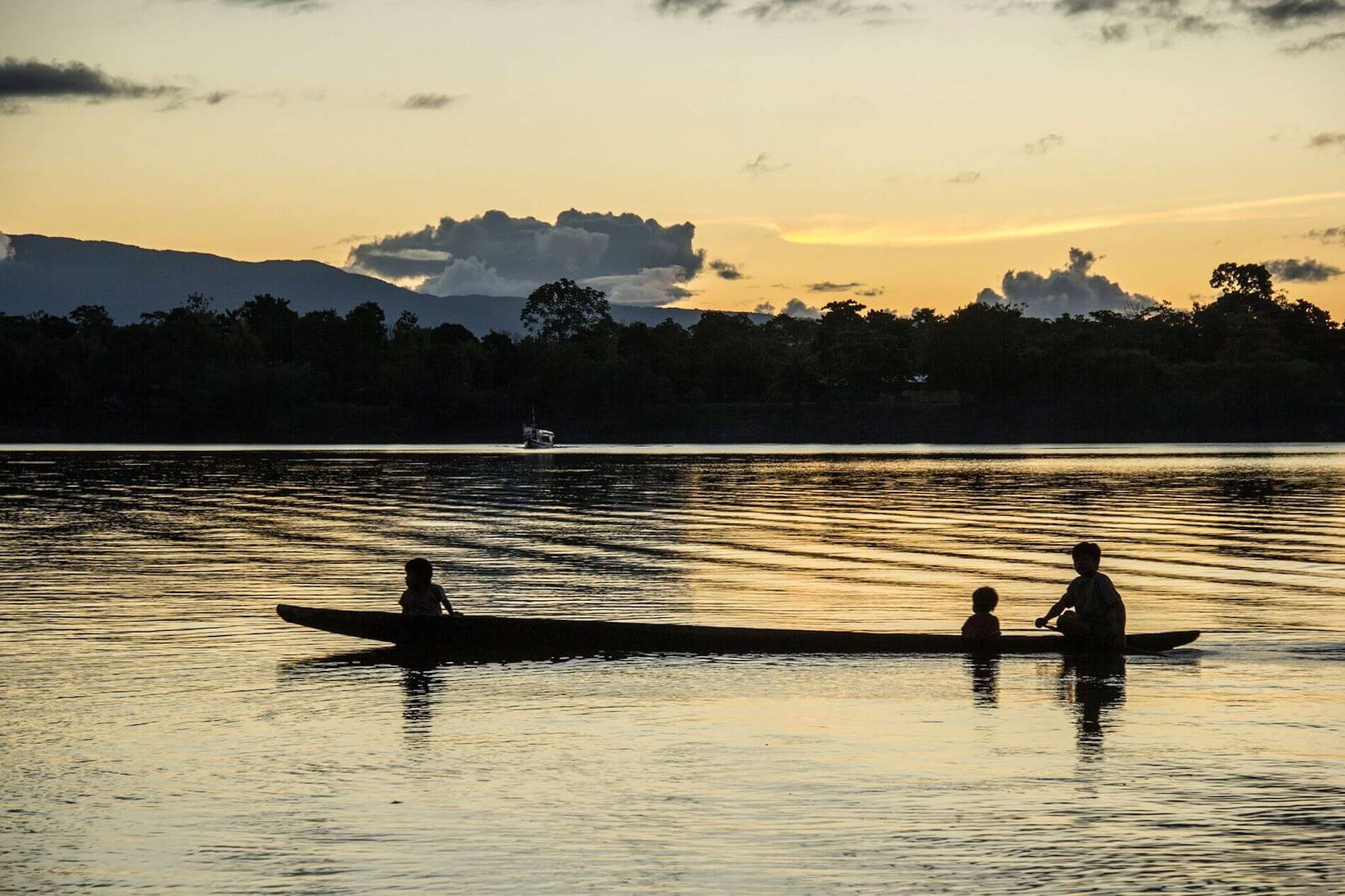
by Deep Green Resistance News Service | Jul 14, 2018 | Colonialism & Conquest
Featured image: The Shipibo-Konibo people rely on forests for hunting, fishing and natural resources. Photo by Juan Carlos Huayllapuma/CIFOR
by World Resources Institute via Intercontinental Cry
The Santa Clara de Uchunya community has lived in a remote section of the Peruvian Amazon for generations. Like many indigenous groups, this community of the Shipibo-Konibo people have traditionally managed and relied on forests for hunting, fishing and natural resources.
But in 2014, someone started cutting down large sections of the community’s ancestral forests.
Without community members’ knowledge or consent, the regional government had given away 200 parcels of land, which were then bought by palm oil company Plantaciones de Pucallpa, part of a foreign group of companies with known environmental and legal troubles.
Community members turned to indigenous organization FECONAU for help, but there was a problem: Santa Clara de Uchunya only had formal legal title to a small sliver of their ancestral lands — about 218 hectares (539 acres) out of some 8,000 hectares (19,800 acres) they occupied.
So in 2015, the community requested an extension of their title to their full ancestral lands. The Regional Government responded bymaking vague promises and implying that the existence of competing claims to the land made any action impossible. Faced with administrative inaction, the community filed a lawsuit to compel the government to recognize their constitutional rights to their ancestral land.
The lawsuit remains stuck in the courts, and the community has only been able to obtain a government commitment to a small 750-hectare extension. When officials and community members tried to complete the necessary mapping for this extension, a large crowd, presumably affiliated with the palm oil operations, blocked their path.
Community members continue to advocate, but they’ve been met with intensifying violence. Unknown armed men came to their homes, making threats like “we are ready to kill.” They beat a community member who refused to leave his land and opened fire on a community delegation trying to gather evidence of deforestation.
Meanwhile, palm oil operations continue, despite multiple injunctions ordering a halt to the company’s operations for failing to obtain proper permits and for illegally deforesting at least 5,300 hectares (13,000 acres).
“We never thought that we would have such problems with transnational companies,” said Carlos Hoyos Soria, leader of the Santa Clara de Uchunya community. “We live from hunting, fishing — from the resources that the forest has to offer. Indigenous people without land are nothing.”
Santa Clara de Uchunya’s Struggle for Land Rights Is a Global One
The story of Santa Clara de Uchunya is all too familiar. New WRI research finds that across 15 countries in Latin America, Africa and Asia, rural communities and Indigenous Peoples face steep challenges to formalizing their land rights. While they wait decades for legal titles that may never come, companies acquire land or begin operations in as little as 30 days (experience the difference in processes through our interactive infographic). The resulting conflicts over the contested land can last years, displacing communities and creating significant legal and economic risks for companies.
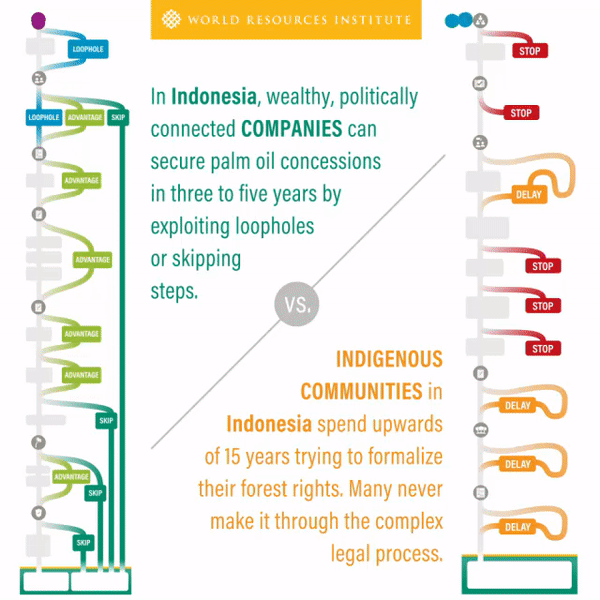
Indigenous Peoples and rural communities occupy more than half of the world’s land, but they legally own just 10 percent of land globally. Obtaining formal land rights is one of many tools they use to try and protect their land, but our research finds clear inequities in these procedures:
Communities face an uphill battle when trying to obtain formal rights to their land. Many communities do not realize that their customary forms of land ownership lack legal protection; those that do often lack the legal knowledge and resources to begin the process of applying for formal rights. While laws differ by country, land formalization procedures often involve difficult steps like writing technical reports or legal documents. In practice, most communities need help from an outside non-profit organization. Furthermore, as seen with Santa Clara de Uchunya, when conflicts or overlapping land rights and concessions exist, communities may be unable to title their lands at all. We found this to be a key challenge not only in Peru, but also in countries like Indonesia, Tanzania, Guyana and Mozambique.
Even when communities do obtain titles, these documents exclude ancestral lands and natural resources. Santa Clara de Uchunya’s original title was a tiny sliver of their total territory. Many communities similarly have ancestral lands excluded from their titles, with government authorities imposing arbitrary caps on the size of land they grant to communities. Elsewhere, certain types of land cannot be included in titles: in Peru, communities must complete a separate procedure if the government classifies the land as “forestland.” Even then, they can only get a contract to use their land (a cesión en uso), not ownership rights. In practice, only a few communities have been able to obtain this contract.
Some companies take shortcuts when acquiring land, with serious social and environmental consequences. Laws and policies regulating how companies obtain land are sometimes conflicting or inconsistent, leaving loopholes that companies can exploit to acquire land more quickly. Like Plantaciones de Pucallpa, which did not properly complete social and environmental licensing before beginning its operations, some companies take advantage of governments’ limited abilities to monitor for misconduct. This not only hurts communities, but also sets companies that do carefully screen for environmental and social risks at a competitive disadvantage compared to those taking shortcuts.
Getting to the Root of the Land Rights Problem
Investigating environmental crimes and problematic land transactions after they occur comes too late, and is expensive and time-consuming. A far better solution is to solve the land issues at the root of these problems. Governments should recognize indigenous and community land rights, engage in better monitoring of company misconduct during land acquisitions, and ensure that businesses secure the free, prior and informed consent of the people who live on the land before they begin operations.
LEARN MORE: Read the full report, The Scramble for Land Rights: Reducing Inequity Between Communities and Companies

by Deep Green Resistance News Service | Jul 11, 2018 | Mining & Drilling, NEWS
by Center for Biological Diversity
SALT LAKE CITY— Conservation groups today formally opposed the Trump administration’s plan to facilitate the first commercial oil shale development in the United States, a massive Utah project that would generate enormous greenhouse gas and deadly ozone pollution in regions already exceeding federal air-pollution standards.
The Bureau of Land Management plans to grant the Estonia-owned Enefit American Oil rights of way to build water, gas, electric and oil-product lines to its 13,000-acre strip-mining “South Project” on private land. In total Enefit has 30,000 acres of private, state and public-land leases in the Uintah Basin. The land contains an estimated 2.6 billion barrels of kerogen oil, and its extraction would require pumping billions of gallons from the Colorado River Basin.
“This plan would turn plateaus into strip mines, pull precious water from our rivers, and cause dangerous climate and ozone pollution. It’s everything the Colorado River Basin doesn’t need,” said John Weisheit, a river guide and the conservation director of Living Rivers. “The BLM should dump this plan and stop wasting time and money by propping up Enefit’s wild speculation.”
“The Colorado River Basin is in crisis thanks to water shortages caused by overallocation, mismanagement, and devastating climate change,” said Daniel E. Estrin, advocacy director at Waterkeeper Alliance. “Enabling development of one of the most carbon and water-intensive dirty fuel projects in the nation in the Upper Colorado River Basin will only exacerbate the decline of our waterways and our climate.”
The South Project would produce 547 million barrels of oil over three decades, spewing more than 200 million tons of greenhouse gas — as much as 50 coal-fired power plants in a year. The amount of energy it takes to mine and process oil shale make it one of the most carbon-intensive fossil fuels on Earth.
“This project would be a climate and health disaster,” said Taylor McKinnon of the Center for Biological Diversity. “The last thing the Colorado River Basin needs is a new fossil fuel industry warming the climate, sucking rivers dry and choking communities with more deadly ozone pollution.”
The BLM refused to look at the air, climate and other potential damage from the development, claiming that Enefit would build the project even without the rights of way. But in fact Enefit would be financially and technically unable to build the project otherwise. Ignoring the development’s potential environmental damage violates the National Environmental Policy Act.
“Oil shale is a dirty fuel that does not deserve a foothold on our public lands,” said Alex Hardee, associate attorney at Earthjustice. “BLM’s action will facilitate depletion of the Upper Colorado River watershed, increased smog pollution in the Uinta Basin, the destruction of wildlife habitat, and substantial greenhouse gas emissions.”
“Without BLM’s approval of rights-of-way across public lands, Enefit would need to truck water, natural gas, and processed oil—more than one truck every 80 seconds for 30 years,” said Grand Canyon Trust staff attorney Michael Toll. “Without this federal subsidy, it’s unlikely Enefit could afford to move forward. Why should Americans subsidize an otherwise unfeasible oil shale project, especially when BLM has yet to comply with the National Environmental Policy Act’s mandate to fully analyze and inform the public of the impacts of Enefit’s proposed project?”
The project would double oil production in the Uintah Basin and refine that oil near Salt Lake City, worsening ozone pollution in both areas. In May the Environmental Protection Agency determined that air pollution in the Uintah Basin and Salt Lake City exceeds federal health standards.
“The Uinta Basin suffers from some of the worst air quality in the nation,” said Landon Newell, a staff attorney with the Southern Utah Wilderness Alliance. “BLM’s kowtowing to the fossil fuel industry is largely to blame for the current crisis and its approval of this energy intensive, environmentally destructive, boondoggle of a project will only worsen the problem.”
“A pollution crisis will inevitably lead to a public health crisis, and there is preliminary evidence that one may already be occurring with high rates of perinatal deaths in the Uinta Basin,” said Dr. Brian Moench, board president of Utah Physicians for a Healthy Environment. “The health risks go well beyond ozone and particulate pollution. Although VOCs are not addressed by EPA national standards, they likely represent the greatest toxicity to the population, especially for infants and pregnant mothers.”
“The last thing we need is an Estonian oil company using Americans’ public land to prop up destructive oil shale mining. Yet the Trump Administration’s BLM failed to give this dirty energy subsidy the hard look it demands,” said Jacob Eisenberg of the Natural Resources Defense Council. “Enefit is a company with an extraordinarily dubious environmental track record; NRDC opposes its proposal for the harm it could do to our natural heritage, climate, and public health.”
Enefit’s oil-shale operation would draw more than 100 billion gallons of water from the Colorado River Basin over the next three decades, threatening endangered fish recovery and exacerbating flow declines in the Green and Colorado rivers downstream. The project would also generate more than 450 million cubic feet of waste rock every year, much of it toxic.
“Now is the time to accelerate the transition to clean energy, not to sacrifice our water, air quality, and climate for an investment in one of the dirtiest fossil fuels on the planet,” said Sierra Club beyond dirty fuels associate director Cathy Collentine. “The Sierra Club and our allies will continue to fight to ensure that this dirty mining project never goes forward.”
The BLM is moving forward with this development even as the Colorado River Basin suffers climate-driven river flow declines, record droughts and wildfires.
Photo by Darla Hueske on Unsplash
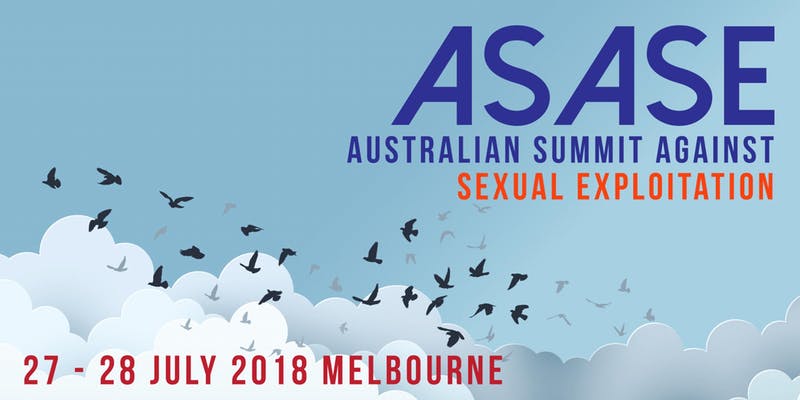
by Deep Green Resistance News Service | Jul 10, 2018 | Prostitution
by Joanna Pinkiewicz / Deep Green Resistance Australia
Australia has different legislations in regards to prostitution in each state. For example New South Wales has almost full decriminalisation and definitely in favour of brothel owners, less so for individual, who can be charged for “living on the earnings of prostitute” or soliciting for prostitution outside dwelling, school, church or hospital. In Victoria street sex work is illegal and brothels and premises based work needs to be licenced. In reality, NSW police reports show that legal operations have connections to organised crime, drug and people trafficking and in Victoria we are seeing surge in premises, both registered and under the cover of massage parlours and unchecked conditions and practices within registered brothels.
While many countries in Europe and recently in the US (US Greens Party voted for change in policy on prostitution and support the Nordic Model) the push to introduce the abolitionist approach has been coming from the left in the name of justice and equality for women, in Australia the left has been supporting the “sex worker” lobby groups and the sex industry itself, contributing to normalisation of sex purchase by men and expansion of the sex trade industry.
It came as a bit as a surprise to see that in April a branch of Victorian Liberal Party proposed a motion in support of the Nordic Model, which aims at addressing the demand for prostitution via penalising the buyer and not targeting those who are in prostitution.
It also came as a surprise to have a very public supporter of the Nordic Model within the Greens Party, Kathleen Maltzahn, state that she won’t support the Vic Liberal Party’s motion for the Nordic Model if and when it goes up for a vote. Maltzahn is known for her grass roots work, Project Respect, an exit program for women in prostitution, which she established after working in Philippines and seeing first-hand the insidious nature of sex trade. She has been going against her own party’s policy, which supports full decriminalisation. She has been widely criticised by those in her own party as well as those in the pro sex lobby groups. Upon the release of her statement, a criticism also came from parts of the abolition movement. I does look like a significant pressure has been placed upon her from the party leaders to make that statement. One thing is clear, we need more radical feminist analysis of prostitution in the Green’s party, more radical feminists being active within the mainstream left to bring about change.
Many activists within the abolishion movement hesitate at working with the Liberal Party or Christian organisations, due to disagreements on details or due to their stand regarding other women’s rights issues.
I have asked Simone Watson, director of Nordic Model Australia Coalition, what she thinks about working with the Liberal Party on this and she said this:
“My concerns around the Victorian Liberal Party endorsement of the Nordic/Abolitionist Model were that their first proposal was not in fact the Nordic/Abolitionist model at all.
“The initial draft was a serious red flag to me as it only focused on criminalising buyers in illegal brothels. It is already illegal to buy sexual access in illegal brothels. Yes, it aimed to decriminalise the prostituted women in those same brothels, but offered no exit programs and no changes to legislation across the board. So my reading of it was that it would be doomed to failure. I do not think my concerns around such a premise are unwarranted. It failed to take in to account the inefficacy of prohibition laws on prostitution; it failed to capture the intrinsic and essential point of the abolitionist approach. Their proposal was still rooted in the dangerous ground of prohibition. And prohibition fails. Some saw this as at least a start, however, the Nordic/Abolitionist Model cannot be undertaken half-baked. To do so would be incredibly dangerous and anathema to the law they claimed to be endorsing. To their credit they have since recognised that their initial proposal was incomplete.
“Do I trust them? Well, I have some trust, especially as they took considerable time to listen to survivor’s and our allies’ concerns on this. They certainly have taken more time than the Greens or Labor, which is why the Green Party USA should be commended for their determination to support the abolition of the sex trade and all major parties here should take note of that.
“For me, working with political parties as a sex-trade abolitionist is fraught because I often do not agree with many of their other policies. For example the Liberal’s alliance with anti-woman organisations, those who are against abortion and so on. But if a party is truly dedicated to abolishing the sex-trade, extinguishing the ongoing commodification of women, and women’s rights to be free from sexual exploitation, then I will support them on that particular policy. Again it is hard to trust any particular party on this issue, but if they are willing to amend their initial proposal and actively endorse the Nordic/Abolitionist model as it is intended in full, I support that unequivocally.”
Simone’s response highlights critical issues in approaching the Nordic Model with wrong motivation, poor understanding of the process involved as well as half-baked financial commitment, all critical to its success.
To summarise, the Nordic Model requires a three pronged approach:
- Establishment of exit and support programs for people in prostitution.
- Education of the public and retraining of the police
- Enforcement of the new laws by providing funding to dedicated police people and social workers.
The laws themselves aim at stoping trafficking and curbing growth of the global sex trade via penalising the buyers and pimps.
Other important news from Australia is the upcoming Australian Summit Against Sexual Exploitation (ASASE) on 27-28 of July in Melbourne. Key speakers of the summit on the subject of prostitution are:
- Julie Bindel (UK)
- Sabrinna Valisce (SPACE International)
- Simone Watson (Normac)
- Sarah M Mah (Asian Women for Equality, Canada)
I’m hoping that the summit will bring more allies to the abolition movement in Australia, who can then plan for the consultation process needed when the Nordic Model gets a motion vote in Victoria.
Joanna Pinkiewicz is a DGR Australia member; environmental activist, women’s right activist artist and mother.
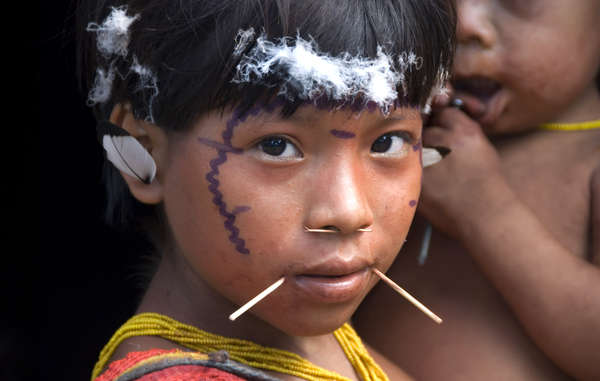
by Deep Green Resistance News Service | Jun 29, 2018 | Colonialism & Conquest
Featured image: The Yanomami are the largest relatively isolated indigenous people in the Amazon. © Fiona Watson/Survival
by Survival International
A measles epidemic has hit an isolated Amazon tribe on the Brazil-Venezuela border which has very little immunity to the disease.
The devastating outbreak has the potential to kill hundreds of tribespeople unless emergency action is taken.
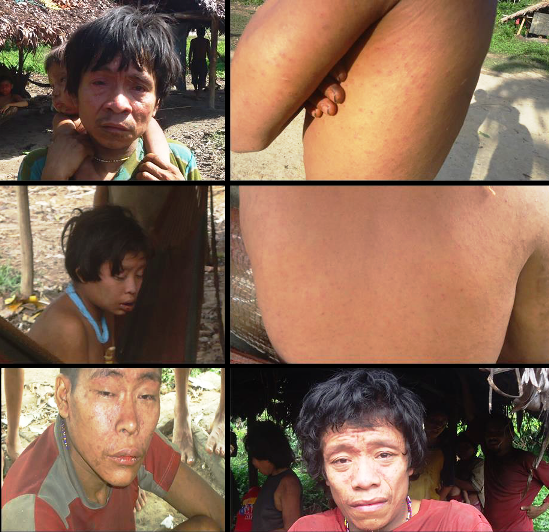
Pictures of Yanomami affected by the current measles outbreak. © Wataniba
The Yanomami communities where the outbreak has occurred are some of the most isolated in the Amazon.
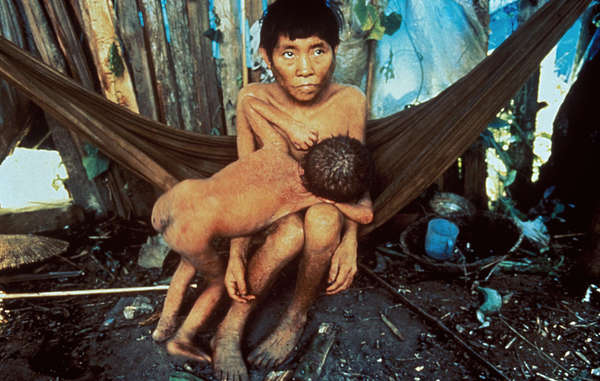
The Yanomami have previously been ravaged by outbreaks of deadly diseases following invasions of their territory by gold miners. © Antonio Ribeiro/Survival
But thousands of gold miners have invaded the region, and they are a likely source of the epidemic. Despite repeated warnings, the authorities have taken little effective action to remove them.
In Brazil, at least 23 Indians have visited a hospital, but most of those affected are far from medical care.

Previous disease outbreaks killed 20% of the Yanomami in Brazil. © Antonio Ribeiro/Survival
Survival International is calling for authorities in Venezuela to provide immediate medical assistance to these remote communities.
Survival’s Director Stephen Corry said today: “When tribal people experience common diseases like measles or flu which they’ve never known before many of them die, and whole populations can be wiped out. These tribes are the most vulnerable peoples on the planet. Urgent medical care is the only thing standing between these communities and utter devastation.”
The Venezuelan NGO Wataniba has released further details on the outbreak (in Spanish).
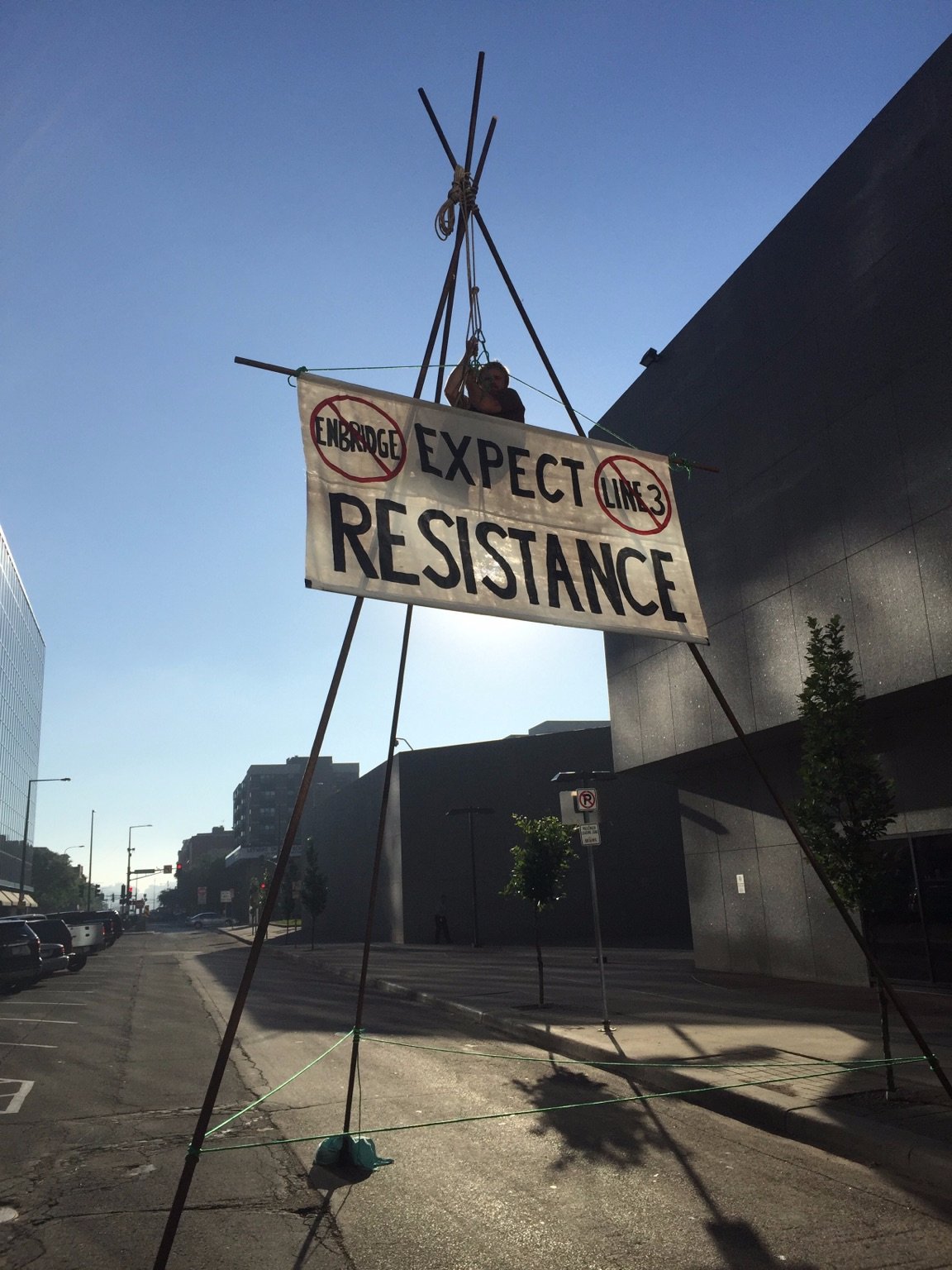
by DGR News Service | Jun 28, 2018 | Biodiversity & Habitat Destruction, Climate Change, Colonialism & Conquest, Indigenous Autonomy, Obstruction & Occupation
For Immediate Release
June 28, 2018
Activist risks arrest in front of Minnesota Public Utilities Commission Office during its final hearings to permit the Line 3 tar sands pipeline
Contact: Ethan Nuss, (218) 380-9047, stopline3mpls@gmail.com
ST PAUL, MN – A water protector ascended a 25-foot steel tripod structure erected in the street in front of the Public Utility Commission (PUC) office to demonstrate ongoing resistance against Enbridge’s proposed Line 3 tar sands pipeline. Today marks one of the final public hearings held by the PUC on its decision to grant a certificate of need to the controversial pipeline.
All five of the directly affected Objibwe Tribal Nations in Minnesota oppose the dangerous project because of the threat it poses to their fresh water, culturally significant wild rice lakes, and tribal sovereignty. Line 3 will accelerate climate change by bringing carbon-intensive tar sands bitumen from Alberta to refineries in the Midwest. Climate change disproportionately impacts Indigenous and frontline communities across the world. This deadly infrastructure project is another example of the genocidal legacy of colonialism faced by Native peoples and the ecological destruction caused by corporate greed. Water protectors, climate justice advocates, landowners, and faith leaders stand united alongside Native communities against this dangerous pipeline.
At around 7AM CST water protectors blockaded traffic by erecting 25-foot steel poles in a tripod structure on 7th Pl. in front of the PUC offices in downtown Saint Paul, MN. Ben, a 30-year-old Minneapolis resident, ascended the structure and unfurled a banner that reads, “Expect Resistance,” a clear message to Enbridge and the PUC that fierce opposition to this pipeline will continue to grow at every stage.
“If the PUC doesn’t stop Line 3, then we will,” said Ben, suspended from the 25-foot structure in the street in front the PUC. “Today’s action isn’t about me but is a demonstration of the growing resistance to Line 3. ” Ben continued, “We’re taking action in solidarity with Native people, who continue to fight for their existence on occupied land and with people all over the world who resist the desecration of nature by extractive industries.”
For photos and live updates go to: twitter.com/ResistLine3
(Update: the tripod was occupied for three years before being vacated)











